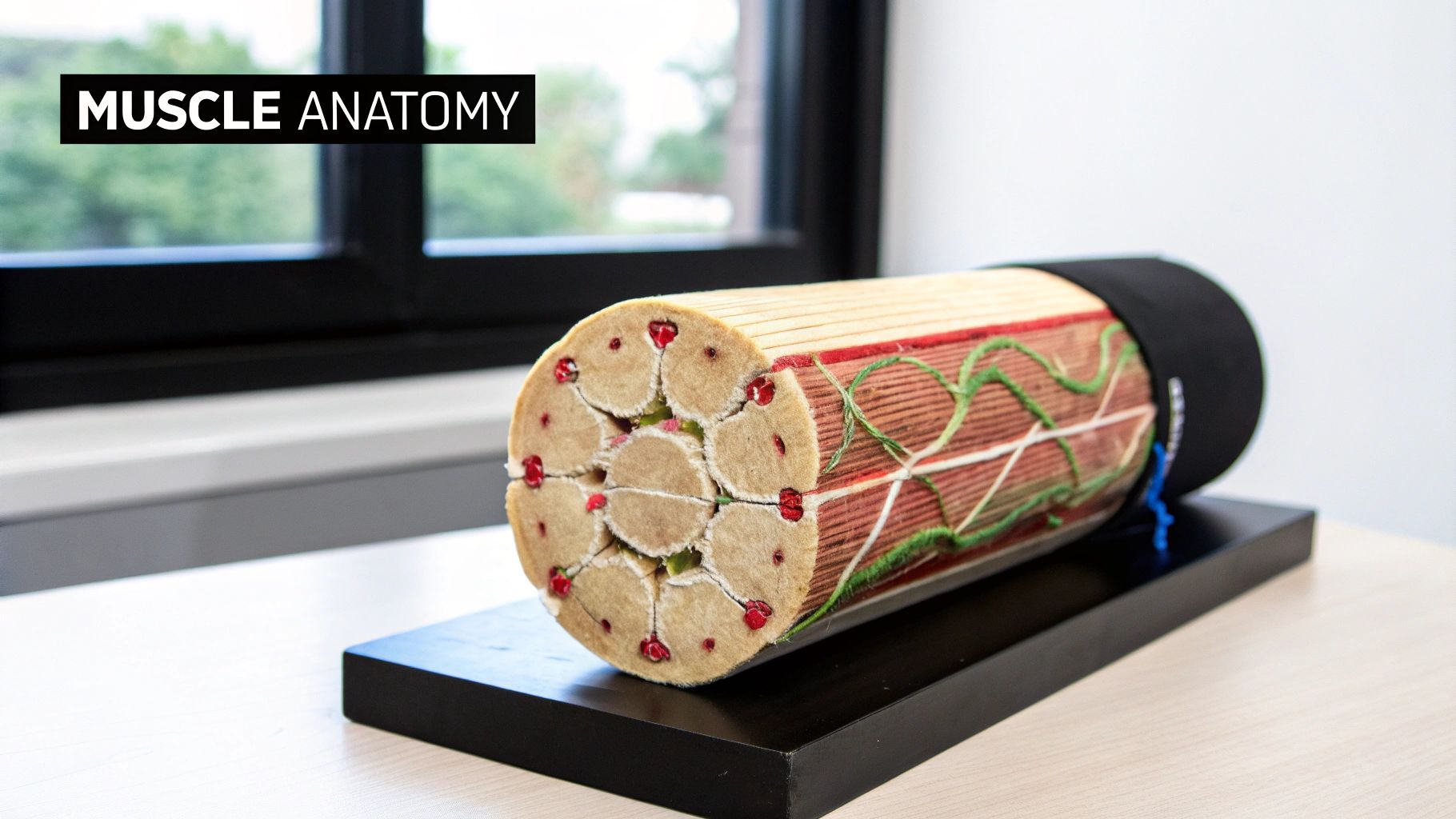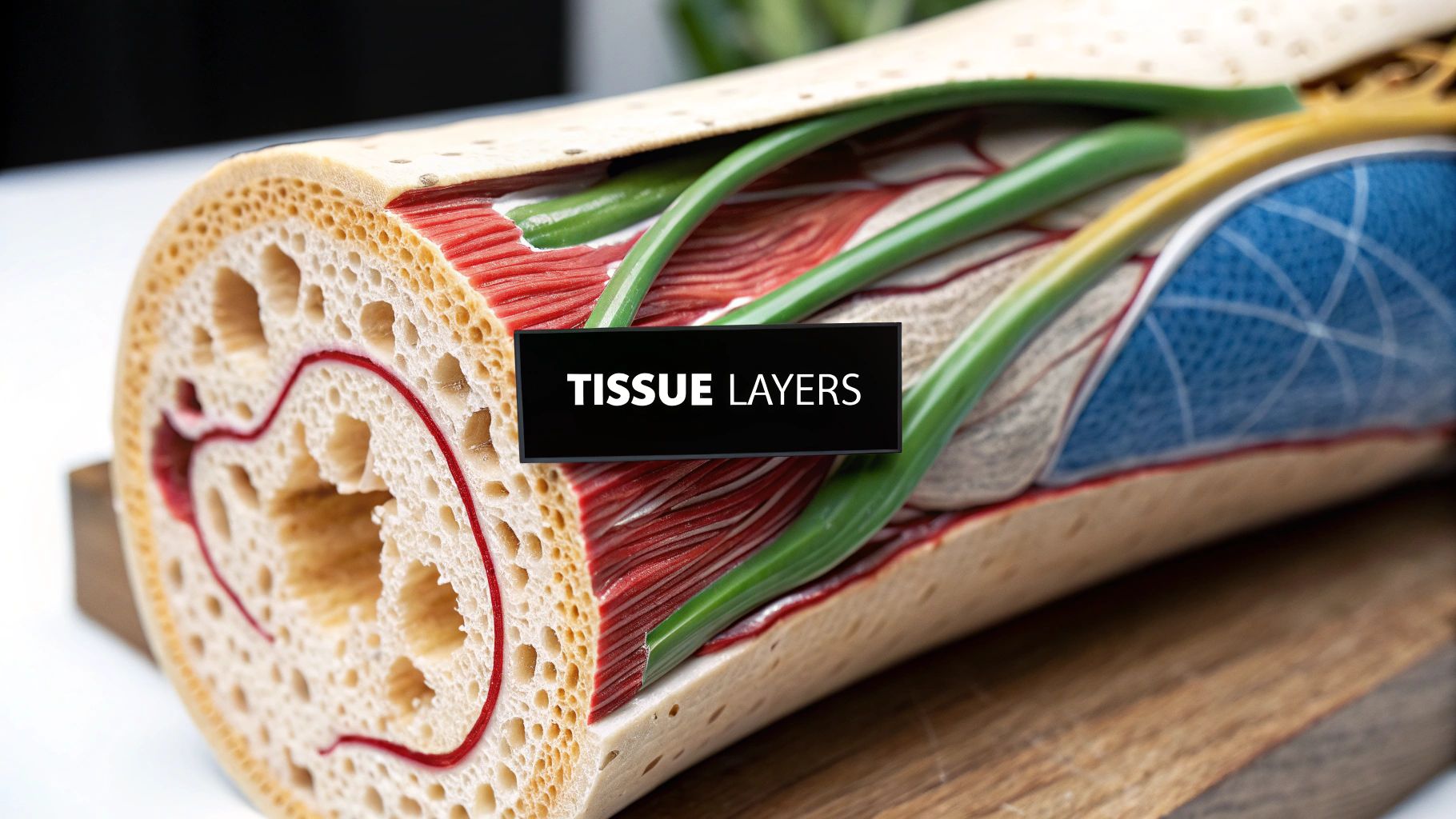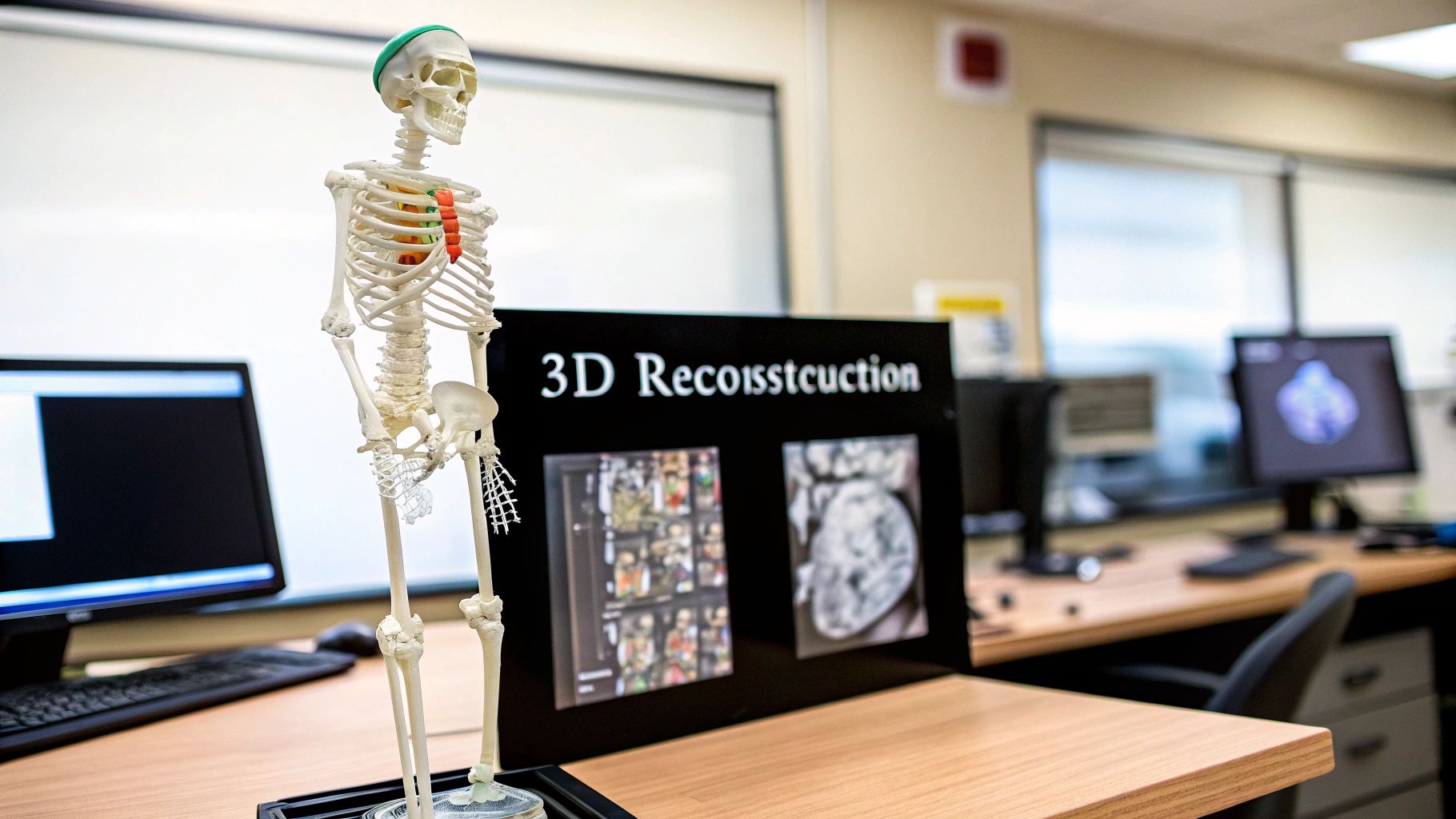The Hidden Architecture of Skeletal Muscle Cross Sections

A cross section of skeletal muscle reveals a complex network of interwoven structures. This intricate architecture is essential for generating force, facilitating movement, and contributing to overall body function. Understanding this hidden world starts with the connective tissue layers that organize and protect muscle fibers.
Connective Tissue: The Scaffolding of Muscle
The outermost layer, the epimysium, encases the entire muscle. It provides structural support and acts as a pathway for blood vessels and nerves. Beneath the epimysium, the perimysium divides the muscle into smaller bundles known as fascicles. This organization allows for coordinated force generation.
Finally, a delicate connective tissue layer called the endomysium surrounds each individual muscle fiber. The endomysium offers protection and serves as a conduit for capillaries and nerve endings. This intricate network ensures that each muscle fiber receives the necessary nutrients and signals.
Muscle Fibers: The Engines of Movement
Numerous muscle fibers reside within each fascicle. These fibers are the basic functional units of skeletal muscle. These long, cylindrical cells contain myofibrils, the contractile elements responsible for generating force. Myofibrils are further divided into repeating units called sarcomeres. Sarcomeres are the fundamental structural and functional units of muscle contraction.
This hierarchical organization, from the whole muscle down to the sarcomere, enables precise control and coordination of muscle activity. The specific arrangement of these sarcomeres gives skeletal muscle its characteristic striated appearance under a microscope.
From History to Modern Imaging: Understanding Muscle Structure
Unraveling the complexity of skeletal muscle structure has been a long journey of scientific discovery. Early anatomical studies distinguished muscle fibers from other cellular components, laying the groundwork for modern analysis. Advances in microscopy and imaging technologies have greatly enhanced our ability to measure muscle cross-sections with precision. This offers deeper insights into muscle function and strength.
Mathematically, geometric models help accurately calculate muscle area and assess muscle dimensions. Learn more about the history of muscle anatomy here. Researchers can now quantify and analyze the intricate details of a muscle cross-section with unprecedented accuracy. This detailed understanding of muscle architecture fuels advancements in sports science, medicine, and rehabilitation.
Microscopic Marvels: What Your Muscle Cross Section Reveals

Looking beyond what the eye can see, a cross section of skeletal muscle reveals a microscopic world essential for movement. This intricate structure is primarily composed of myofibrils, the contractile elements within muscle fibers. These myofibrils are further organized into repeating units known as sarcomeres, the fundamental drivers of muscle contraction.
Myofibrils and Sarcomeres: The Striated Symphony
The specific arrangement of myofibrils and sarcomeres gives skeletal muscle its characteristic striated appearance, a pattern readily observed under a microscope. This striation results from the alternating light and dark bands created by overlapping protein filaments within the sarcomeres. These proteins, actin and myosin, interact to produce the force responsible for muscle contraction. Like a well-coordinated orchestra, this interaction powers every movement we make, from subtle gestures to powerful athletic feats.
Staining Techniques: Illuminating the Microscopic World
Researchers use various staining techniques to highlight specific components within a muscle cross section. These techniques offer valuable insights into the distribution of key structures. For instance, certain stains reveal the complex network of capillaries that deliver oxygen and nutrients to the muscle fibers. Other stains target mitochondria, the powerhouses of the cell, offering information on the muscle's energy production capabilities.
Fiber Type Diversity: Fast-Twitch vs. Slow-Twitch
Examining a muscle cross section also allows scientists to distinguish between fast-twitch and slow-twitch muscle fibers. Categorized as Type I (slow-twitch), Type IIa (fast-twitch oxidative), and Type IIb (fast-twitch glycolytic), these fiber types have distinct properties. Slow-twitch fibers, rich in mitochondria and capillaries, are ideal for endurance activities. In contrast, fast-twitch fibers are designed for rapid, powerful contractions but fatigue more quickly. This difference explains why some individuals excel at marathons while others are better suited for sprinting.
This microscopic view of a muscle cross section helps us understand the factors influencing athletic potential, endurance, and even susceptibility to certain muscle diseases. Analyzing these fiber types provides valuable information about an individual's muscle composition and its implications for performance and overall health. This detailed understanding of muscle at the microscopic level enhances our appreciation for the complex mechanisms that drive human movement.
Measuring Muscle: Cross-Sectional Analysis That Matters

Simply measuring a muscle's diameter doesn't provide a complete picture of its strength. Understanding the cross section of skeletal muscle is crucial for accurate strength assessment. This involves going beyond basic size measurements. This section explores the key methods for analyzing muscle cross sections and their importance in various applications.
Anatomical Cross-Sectional Area (ACSA) vs. Physiological Cross-Sectional Area (PCSA)
Two key metrics are essential for understanding muscle strength: Anatomical Cross-Sectional Area (ACSA) and Physiological Cross-Sectional Area (PCSA). ACSA is a straightforward measurement of the area perpendicular to the muscle's longitudinal axis.
However, ACSA can be misleading as it doesn't account for the angle of muscle fibers, known as the pennation angle. PCSA addresses this by incorporating the pennation angle, the angle between muscle fibers and the tendon.
ACSA is typically measured directly. PCSA, on the other hand, accounts for the pennation angle, which significantly impacts force generation. PCSA tends to be larger than ACSA, reflecting the mechanical advantage of muscle fiber arrangement.
In some muscles, PCSA can be up to six times more effective for generating force than similarly sized non-pennate muscles. Learn more about the impact of pennation angle on muscle force production in this study published by the Royal Society.
The Role of Pennation Angle in Force Production
Visualize two ropes: one straight, the other angled. Pulling both with equal force results in the angled rope producing greater force in the direction of the pull due to the force vector's component aligned with the pull direction.
Similarly, a muscle with a larger pennation angle generates more force along its line of action. Therefore, PCSA, which considers pennation angle, is a more accurate predictor of muscle strength than ACSA. This is especially important when comparing different muscles or assessing training impacts.
Imaging Techniques for Measuring Cross Sections
Modern imaging technology has transformed how we measure muscle cross sections. Magnetic Resonance Imaging (MRI) and ultrasound are commonly used to visualize muscle structure and obtain accurate ACSA and PCSA measurements.
MRI provides highly detailed images, enabling precise measurements of muscle volume, fiber orientation, and pennation angle. Ultrasound offers a more portable and cost-effective option, allowing real-time visualization and measurement of muscle thickness and pennation angle changes during dynamic contractions.
From Images to Insights: Mathematical Modeling
Raw imaging data requires further analysis. Mathematical models translate this data into meaningful insights about muscle function. These models incorporate variables like fiber length, pennation angle, and muscle volume to estimate force production and other performance parameters.
This information has valuable applications in fields like sports medicine, rehabilitation, and ergonomics, enabling professionals to develop targeted training and injury prevention strategies.
To better understand the different methods for measuring muscle cross-sectional area, refer to the table below:
Comparison of Cross-Sectional Area Measurements
This table compares the key characteristics and applications of different cross-sectional area measurement techniques for skeletal muscle.
| Measurement Type | Definition | Best For | Limitations | Typical Applications |
|---|---|---|---|---|
| Anatomical Cross-Sectional Area (ACSA) | Measurement of the cross-sectional area perpendicular to the muscle's longitudinal axis. | Muscles with parallel fiber arrangements. | Doesn't account for pennation angle, can underestimate force production. | Basic muscle morphology studies, initial assessments. |
| Physiological Cross-Sectional Area (PCSA) | Measurement of the cross-sectional area perpendicular to the muscle fibers, accounting for pennation angle. | Muscles with pennate fiber arrangements. | Requires more complex calculations and imaging techniques. | Accurate assessment of muscle force-generating capacity, biomechanical modeling, sports performance analysis. |
This table summarizes the key differences between ACSA and PCSA, highlighting the importance of considering pennation angle for accurate muscle strength assessment. PCSA provides a more comprehensive understanding of muscle function and its potential for force generation.
Size Matters: How Muscle Cross Sections Drive Strength

The relationship between muscle size and strength isn't as simple as "bigger is stronger." While muscle size, particularly the cross section of skeletal muscle, plays a crucial role, other factors contribute to how much force a muscle can produce. This section explores the relationship between muscle cross-sectional area and strength, examining the various influences and differences across individuals and muscle groups.
The Cross-Sectional Area and Force Production: A Complex Relationship
A larger muscle cross-sectional area generally means greater strength. This is because a larger cross section usually contains more muscle fibers, the basic units responsible for generating force. However, the relationship isn't perfectly straightforward.
Factors like neural activation, how effectively the nervous system recruits muscle fibers, and fiber type composition—the balance of fast-twitch and slow-twitch fibers—also affect force production. For instance, individuals with more fast-twitch fibers may be stronger than those with more slow-twitch fibers, even with the same cross-sectional area.
Furthermore, the cross section of skeletal muscle predicts some types of strength better than others. It's a good predictor of isometric strength, the force generated without muscle length change, but less so for dynamic strength during movement. This difference highlights the complexity of muscle function.
The relationship between cross-sectional area and strength can also vary between muscle groups. This is due to variations in muscle architecture, fiber type distribution, and the biomechanical demands on each muscle.
This interplay explains why some people generate more force per unit of muscle. It highlights the importance of considering individual differences in muscle physiology and neural control when assessing strength potential. The cross-sectional area of skeletal muscle is a crucial factor in overall strength.
For example, a study showed that males tend to have a larger cross-sectional area of knee-extensor muscles than females, correlating with greater strength. The ratio of strength to cross-sectional area was slightly higher in males (9.49 ± 1.34) versus females (8.92 ± 1.11), though not statistically significant. This illustrates the influence of anatomy and physiology on muscle performance. Learn more about these sex-based differences here.
Sex-Based Differences: Architecture and Strength Ratios
Research has uncovered sex-based differences in muscle architecture and strength ratios. Males generally have larger muscle cross-sectional areas than females, partially accounting for their higher absolute strength. However, when strength is normalized to muscle size, these differences often lessen, suggesting females generate similar force per unit of muscle cross-sectional area.
These variations arise from a combination of hormonal influences, genetics, and potentially training history. Understanding these sex-based differences is crucial for developing tailored training and rehabilitation programs. This knowledge enables more effective strategies for optimizing muscle performance in different populations.
Transformation: How Muscle Cross Sections Adapt and Change
Our muscles have a remarkable ability to adapt and reshape themselves based on how we use them. Looking at a cross section of skeletal muscle after different types of training reveals fascinating changes. This adaptability is crucial for optimizing how our muscles function and perform in various activities.
Training-Induced Transformations: Resistance vs. Endurance
Resistance training, such as lifting weights, encourages muscle growth by increasing the diameter of muscle fibers. This increase in fiber size is a key factor in building strength and power. Resistance training can also shift the fiber type composition within the muscle, leading to a higher percentage of fast-twitch fibers, which are responsible for quick, powerful contractions.
Resistance training increases muscle fiber diameter for greater strength and power. It also potentially increases the proportion of fast-twitch fibers.
Endurance training, like long-distance running or cycling, brings about a different set of adaptations. While it might not cause the same dramatic increase in fiber size as resistance training, it significantly enhances the muscle's capillary networks. This improved blood flow delivers more oxygen and nutrients to the muscle fibers, boosting endurance.
Endurance training focuses on improving capillary density for better blood flow and oxygen delivery, rather than maximizing fiber size.
These different adaptations highlight the specificity of muscle remodeling. The type of training directly determines the structural changes within the muscle cross section, allowing our muscles to optimize their function for the demands of specific activities.
The Negative Impact of Inactivity and Aging
Unlike the positive adaptations from exercise, periods of immobilization or aging lead to unfavorable changes in muscle structure. Immobilization, such as having a limb in a cast, causes rapid muscle atrophy, or a decrease in fiber size, leading to impaired strength and function.
Immobilization and aging both contribute to muscle atrophy, reducing fiber size and potentially leading to functional impairments.
Similarly, aging causes a gradual decline in both fiber size and number. This age-related muscle loss, known as sarcopenia, can increase the risk of falls and limit mobility. These negative consequences emphasize the importance of staying physically active throughout life.
Sarcopenia, age-related muscle loss, highlights the importance of continued physical activity to maintain muscle health and function.
To illustrate these adaptations, the table below summarizes the key changes seen in skeletal muscle cross sections under various conditions.
To understand how various stimuli impact muscle, a summary table is presented below to highlight the changes occurring in skeletal muscle cross sections.
Cross-Sectional Adaptations to Different Stimuli
This table presents the characteristic changes observable in skeletal muscle cross sections following different types of training, disuse, and pathological conditions.
| Condition/Stimulus | Fiber Size Changes | Fiber Type Shifts | Connective Tissue Changes | Capillary Density |
|---|---|---|---|---|
| Resistance Training | Increase | Shift toward Type II | Increase in collagen | Slight Increase |
| Endurance Training | Slight Increase | Shift toward Type I | Minimal change | Significant Increase |
| Immobilization | Decrease | Variable | May decrease | Decrease |
| Aging | Decrease | Shift toward Type I | Increase in collagen | Decrease |
This table demonstrates how adaptable muscle tissue truly is, highlighting the range of changes it undergoes depending on the stimulus received. Understanding these adaptations is essential for maintaining muscle health and function.
Clinical Applications of Cross-Sectional Analysis
Analyzing muscle cross sections also has important clinical applications. Clinicians can monitor changes in fiber size and composition in response to training, which informs the development of personalized training programs for athletes. This analysis helps track athletic development and identify areas for improvement.
Analysis of muscle cross sections aids in athletic development and monitoring disease progression, showcasing the utility of this technique in both performance and healthcare.
Furthermore, cross-sectional analysis is valuable in tracking disease progression. In conditions like muscular dystrophy, analyzing muscle cross sections allows clinicians to assess the extent of muscle damage and monitor the effectiveness of interventions. This informs more precise treatment strategies.
Evolution's Blueprint: Cross Sections Across Species
A cross section of skeletal muscle offers a fascinating view, not only into the inner workings of our bodies, but also into our evolutionary journey. Comparing these cross sections between different species illuminates the adaptations that have shaped movement and survival over millions of years.
Primate Parallels: Insights From Our Closest Relatives
Comparing human muscle structure to that of our closest primate relatives, like chimpanzees and gorillas, offers valuable insights. We share a common ancestor, yet our evolutionary paths have diverged, leading to distinct differences in muscle structure. These differences reflect the unique demands of human bipedal locomotion and the fine motor skills of our hands. Our upright posture and ability to use tools have driven changes in the size, shape, and fiber arrangement within the muscles of our limbs.
Body Mass, Muscle, and Locomotion
The relationship between body mass and muscle cross-sectional properties is key to understanding how efficiently an animal moves. Larger animals typically have larger muscle cross sections to support their increased weight. However, the scaling isn't always directly proportional. Skeletal muscle cross-sectional area plays a vital role in locomotion and generating force. Research shows that muscle cross-sectional areas scale with body mass in humans, especially in the leg muscles. For example, the gastrocnemius medialis and lateralis muscles exhibit positive allometry. This means their cross-sectional area increases disproportionately more than body size. This adaptation increases the force production needed for human locomotion, a distinguishing feature compared to other primates like great apes. Learn more about these adaptations here.
From Evolution to Innovation: Applications in Medicine and Performance
Studying cross sections across species has practical implications beyond evolutionary biology. Scientists are using these insights to develop new treatments for muscle disorders and improve human performance. By understanding the variations in muscle architecture and function across the animal kingdom, we can identify potential targets for therapies and develop strategies for increasing muscle strength and endurance. This evolutionary perspective provides a fundamental understanding of how our muscular system is designed and how it functions.
Looking to integrate AI into your medical imaging analysis? PYCAD offers comprehensive AI solutions for medical device manufacturers and healthcare technology companies. From data management and model training to seamless deployment, PYCAD helps optimize medical devices for improved diagnostic accuracy and efficiency. Visit PYCAD to learn more and explore how AI can benefit your medical imaging processes.






